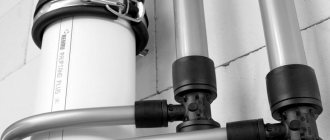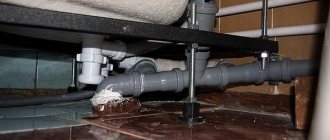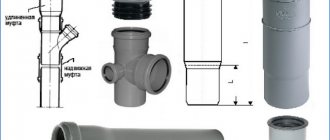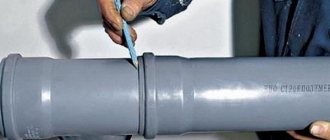Is it necessary to replace the cast iron riser with a plastic one, let's decide. Cast iron sewerage was installed everywhere in the last century, and it had many advantages. The sewer riser minimized noise during operation of the sewer system, and its service life was tens of years. These risers are found in many apartments to this day.
Indeed, if a cast iron pipe is not destroyed by corrosion and passes wastewater well, then there is no point in replacing it. But if the service life of such a riser has already been completely exhausted, as evidenced by its leaks and the appearance of unpleasant odors in the bathroom, then replacing the cast iron riser with a plastic one would be a good solution.
It is worth noting that now when installing sewerage systems, preference is given to plastic. This material is lightweight and sufficiently durable, but its most important advantage is its anti-corrosion. The plastic sewer riser does not become overgrown with deposits from the inside and does not rust over time. The only drawback is its weak soundproofing properties, that is, the use of sewerage is accompanied by noise.
Installing plastic sewer pipes or replacing a cast iron riser with a plastic one is not particularly difficult, and no special equipment is required. The light weight of the pipes and fittings and their simple joining make all the work quick, which is why residents increasingly prefer to carry out such work themselves.
Rules for replacement
Maintenance of sewerage systems made of cast iron is fundamentally different from maintenance of utilities made of polypropylene. Therefore, if we are talking about an apartment building, repairs are preceded by submitting an application to the management company.
All work is carried out only after obtaining permission for individual actions on a separate site.
In the event of unauthorized insertion of PVC pipes into a cast-iron communal riser, the house management legally declines responsibility for emergency situations.
In what cases may a gas burner be required?
In general, in older buildings, sewer sealing was carried out using sulfur, which is not so easy to remove. However, this can be done with fire. When contacting such a substance, harmful fumes appear, so it is necessary to use a respirator.
When sealing is done using cement mortar, it needs to be crushed and cleaned. It is important here not to damage the integrity of the lower part of the pipe.
Upon completion of dismantling, the junction of old and new sewer products must be thoroughly cleaned.
Dismantling
Replacing a cast iron riser with a plastic one requires knowledge and experience. If you are not sure of the presence of both, you should invite a plumber.
Before replacing a cast iron drain with a plastic one, you should make sure you have the following tools:
- perforator;
- Bulgarian;
- grinding discs;
- adjustable wrench;
- chisels;
- screwdrivers.
Stage 1. The junction of the cast iron elements is identified.
Stage 2. The connection method is determined. Combining the tee with the cross and the pipe can be done using:
- sulfur filling;
- mixtures of cement and polymer;
- caulking with mortar.
Stage 3.
The cast iron structure is dismantled. Using a pipe cutter or grinder, a pipe standing vertically is cut into 15-centimeter pieces. The cut should be made at an angle of 15-20 degrees, two-thirds of the perimeter.
The cut sections are dismantled using a chisel. In this case, care must be taken to ensure that residues do not get into the sewer.
The top edge is cut at a pre-measured height. The height parameters must correspond to the shaped product. The cut is made in accordance with the horizontal line. The location of the upcoming cut is marked with masking tape.
Stage 4. The lower part of the riser consists of several parts. Each part is cleaned in turn at the connecting seams and broken out from the overall structure. The connecting seams in the nodes are removed using a hammer drill. The remaining solution is removed with a chisel.
Dismantling cast iron sewer risers is often difficult due to the lack of a seam or strong gluing of parts together. To expand the joint, a metal blade is used. Otherwise, the pipe is cut 3–5 cm above the joint.
The riser pipes, sealed with sulfur, are preheated with a blowtorch at the junction. To replace a cast iron sewer tee, carefully rock the heated pipe until the elements separate. Sulfur has a strong unpleasant odor and its fumes are poisonous.
Advantages and disadvantages of cast iron pipes
In Soviet times, there was no alternative to cast iron pipes. For a long time, no one simply worked on developing alternative types of sewage systems. The main reason for this was the advantages of cast iron sewerage:
- strength, resistance to temperature and mechanical loads;
- durability;
- reliability, ability to work with aggressive or abrasive liquids;
- low noise level.
However, cast iron systems have a number of disadvantages:
- complexity of installation. Each connection must be separately sealed and sealed;
- the heavy weight of the pipes creates a load on the supporting structures. In addition, strong and reliable fasteners are required;
- cast iron is brittle. It does not tolerate sharp impacts or deforming loads. If a crack or chip appears in the bell, it is impossible to get rid of them. Various temporary measures are used, but it is impossible to completely restore the condition of the defective area;
- metal is prone to corrosion;
- the surface of the castings is rough. This promotes the adhesion of organic particles and fat. Over time, the layers increase, change the cross-section of the pipe, and form blockages.
The widespread replacement of cast iron sewers is caused by these shortcomings. Sometimes pipes that are still fully functional are replaced in order to obtain compatible, easy-to-repair parts of the system.
Installation
Before starting work, you should purchase all structural elements:
- The seal is a rubber cuff that ensures tightness at the joints when replacing a tee in a sewer riser.
- Plastic tee.
- Sewer pipe with markings corresponding to the size of the tee.
- Compensators with a diameter that matches the size of the pipe - base.
- Pipe adapters, clamps, fastenings.
- Bends, sockets.
- Protective equipment: respirator, gloves, goggles.
The replacement process begins by installing a rubber cuff into the pipe socket. To do this, a cross or tee is inserted. For a tight connection, the end is washed with a dense layer. Additionally, you can treat it with a silicone mixture applied to the linen winding.
Next, the pipes are cut into calculated pieces, and the end is chamfered. The exact length is determined by inserting the product into the pipe. The resulting structure is inserted into a pipe located in the upper ceiling.
The distance between the tee and the structure should not exceed 30 mm. Preparatory assembly is performed without the use of cuffs and gaskets.
Sliding couplings are used to tightly join the cast iron section with the plastic section.
At the final stage of assembly, gaskets, couplings, and cuffs are installed. Fasteners and clamps are clamped. The joints are checked. Polyurethane foam fills the voids between the floors. The throughput functionality of the assembled system is checked.
Types of sewer pipes
We will not consider absolutely all types of sewer pipes that are used in industry and utilities - a simple listing will suffice. We are now more concerned with cast iron, polyvinyl chloride and polypropylene; these are the materials we have to deal with at the household level.
What pipe materials are used in sewers in general:
- steel, GOST 8732–78 and GOST 10704–91;
- cast iron, GOST 6942–98;
- ceramics, GOST 286–82;
- concrete, GOST 6482–88;
- asbestos-cement, GOST 1839–80;
- cross-linked polyethylene GOST 22689.2–89;
- polypropylene, GOST 22689.2–89;
- polyvinyl chloride, GOST 22689.2–89.
Who is obliged to change the sewer riser?
The state regulates the rules for maintaining property in apartment buildings, including the replacement of the sewer riser, since the riser itself and the drain from it to the first joint are the common property of the house.
Regulations:
- Government Decree No. 491 of August 8, 2006 on the maintenance of common property.
- Manual on repair and maintenance of common property dated April 2, 2004.
- Resolution of the State Construction Committee No. 170 of September 27 on the standards of technical operation of the housing stock.
We recommend that you read: How to build a garage from a profile pipe?
All maintenance, repair and replacement work is carried out by the management company. It is enough for the owner of the apartment (or the tenant) to write a corresponding statement justifying the reason for the need to carry out work to replace (or repair) the sewer riser.
Next, the work time is agreed upon. The owner of the apartment must provide free access at the agreed time.
Note! A request to pay for work or materials when repairing or replacing a sewer riser, citing its location inside the apartment, is illegal.
Preparation for work and tools
For dismantling you will need sledgehammers, hammers, grinders, and a hammer drill. It may take several discs for an angle grinder; the work is quite exhausting.
In some cases, a gas torch or blowtorch may be required.
Tools for replacing the riser
Chisels, special hammer - chisel, screwdrivers, metal wedge, silicone sealants. You will also need stepladders or sawhorses. It is highly undesirable to carry out work on dismantling cast iron sewer pipes alone.
Materials for work
- Rubber cuffs - seals to ensure tightness of joints with a cast iron pipe, if provided;
- 11 cm plastic tee or cross;
- Sewer plastic pipe 110 mm. Be sure to check the labeling that this is the sewer option. This point is important because sewage effluents have a high level of aggressiveness. In addition, the pipe must be resistant to acid- or alkaline-based cleaning agents;
- Pipe diameter compensators;
- Plastic adapters with cuffs;
- Clamps and fastenings for pipes;
- Plastic bends for possible alignment of the riser.
Plastic pipe for internal sewerage 110 mm
Don't forget about personal protection. Thick construction gloves and mittens and safety glasses are required. You will also need a respirator with a fresh filter or a gas mask. Wearing work clothes with tight and soft knee protection will help you prevent the development of joint diseases.
The water supply must be shut off throughout the entire riser. Notices should be posted at the entrance in advance to warn residents. It is advisable to also visit all apartments and notify additionally about the time of work.
When should you switch from cast iron to plastic?
Homes built decades ago have cast iron and steel piping installed. In cast iron products, blockages sometimes fill most of the diameter. The reason is the lumpy surface of the material. Pipes wear out, crack, and leak. An unpleasant odor appears in the room. This is a signal to replace cast iron with a higher quality material.
In houses being built today, plastic pipelines are most often installed. Hot and cold water are passed through them. The advantages of products made of polypropylene or PVC are as follows:
- they are light in weight;
- when installing plastic products, no special equipment is required;
- the smooth surface inside the pipes reduces the likelihood of blockages;
- products are not subject to corrosion.
They also have a minus: low noise insulation characteristics. But the advantages compensate for this disadvantage. Therefore, replacing cast iron sewer pipes with plastic ones is justified. It is best to change them during repair work. It is recommended to replace cast iron products with plastic ones 25 years after installation of the sewer system.
Work order
Installation of a new riser is carried out in a certain sequence. In order for this process to proceed without complications, it is necessary to provide for a number of points.
Precautionary measures
Carrying out plumbing work involves the use of electric tools, contact with toxic fumes, and sharp and heavy objects.
The following safety precautions must be observed:
- ensure good ventilation of the bathroom;
- use an insulating or filtering gas mask;
- perform work wearing protective gloves, goggles and an assembly helmet;
- use proper electric tools.
You should decide in advance how to secure the riser from above so that it does not fall along with the tee onto the repairman during the repair process.
How to prepare for the replacement process
In order for the installation of a new riser to be completed quickly and efficiently, it is necessary to carefully plan this work. You should check in advance the possibility of dismantling the toilet, draw up a diagram of the location of the tee sockets, inserts, fittings and adapters.
Everything should be at hand so as not to interrupt work to go to the store for missing items.
Devices tools and materials
In order to change the riser, the following tools and materials are needed:
- perforator;
- hammer;
- Bulgarian;
- oil level;
- screwdrivers;
- putty knife;
- chisel;
- pipes with a diameter of 50 mm and 100 mm;
- sealing agents;
- clamps;
- plastic dowels and screws for them.
It is advisable to prepare garbage bags and boxes, rags and buckets to collect dirt and water.
How to connect pipes
The technology is almost the same for products made from all materials.
The straight part of the pipe is inserted into the socket, inside of which there is a seal.
Sealing
This process is carried out using the following materials:
- tow;
- jute rope;
- automotive lubricant;
- silicone;
- Teflon tape;
- self-adhesive film.
Additional sealing is needed in cases where the riser will be sheathed with a rigid stationary box.
Checking for leaks
This procedure must be carried out to ensure the quality of the work performed. A dense material tied to a rope is inserted into the inspection hole and moved below the tee in the floor. After this, the drain is filled with water and a pause is maintained for 20-30 minutes.
If there are no leaks, then the final installation was carried out efficiently.
After this, the riser can be closed, not forgetting about installing sound insulation.
At whose expense
Since the sewer riser is common property, its repair or partial replacement is carried out at the expense of the apartment owners. If tenants live under a social tenancy agreement, then the owner of the property is the state. In this case, the costs are compensated by the municipal budget.
The planned replacement of a sewer riser in an apartment building can be financed from funds allocated by residents for major repairs of the house.
The owner of the apartment, as well as the tenant, independently pays for materials and work to replace part of the riser in his apartment if he decides to change working communications at his own request. Such a replacement can be made, for example, during a major renovation of an apartment or during redevelopment.
Note! Payment for the work and costs of materials is made by the owner of the property. However, in the case of common property, this occurs through monthly payments for housing maintenance.











